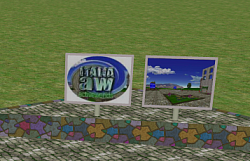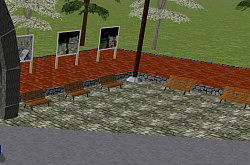Frequently Asked Questions
Communicate
Talking to others is an integral part of the Active Worlds Browser experience. When you enter a world, you will notice the avatars of other users without their respective names displayed above their heads. However, as soon as users start talking, you will be able to see their names and what they say above their respective avatars. Over time, what they say will change, but you will always be able to see their names above their heads. In any case, you will be able to hear what people say even if they are behind you or to the side, as long as they are not too far away. You can always scroll the chat window to review what has been said previously.
**To talk to others:**
To communicate with others, simply type your message in the designated box and press the enter key. Your message will then appear in the Chat window. Other users will see your message above your head until you send a new message, or for about 30 seconds if you don't type another one.
**To mute others:**
If someone is talking but you do not want to listen to them, you can mute them. Just right-click on their avatar and select "Mute" from the list that appears. Later, you can listen to them again by following the same procedure.
**The Chat Window:**
You can resize the chat window using the mouse by clicking on the division between the 3D window and the chat window. Position the mouse on the line that separates them, and when the mouse pointer becomes a vertical arrow, click and drag the edge to your preferred size.
You can also use the scroll bar on the side of the window to view previous messages. Clicking the buttons at the ends will scroll the window one line at a time; clicking inside the bar will scroll the window one page at a time.
In the Chat window, you will also see any error messages that may appear while you are building, for example, if you are trying to place too many objects in the same cell, or if you are trying to modify someone else's properties. These messages come from an omnipotent "Construction Inspector."
Building in Active Worlds
The first rule to keep in mind is that in some Active Worlds environments, building is allowed freely, in others it requires permission from the world curator, and in others it is not allowed at all. The way to determine if you are in a world where building is permitted is to right-click on an object; if the Object Properties window appears, building is possible, although it may require authorization.
These are the worlds where building is and will be allowed for everyone:
America
Atlantis
AW
COFmeta
Mars
Yellow
Building may seem cumbersome to beginners, but reading the following tips thoroughly can clarify things.
Before You Start
The most important thing is to claim a property, and this can be done by completely covering the chosen area with your own objects. Once you have identified the area and its extent according to your needs and ideas to develop, cover it completely with flat and wide objects, such as "walks" or "floors," without leaving any gaps. This way, no one else will be able to place objects in your area, even at high or deep heights.
Unfortunately, many people still believe that simply fencing off the claimed perimeter with trees or other objects around, for example, without occupying the central space, is sufficient. This may work if you rely on the goodwill of others; however, anyone can place non-removable objects in the center of your area.
Activeworlds.com, Inc. receives emails daily from people who do not apply these simple precautions and request intervention from above to remove unwanted objects. But unfortunately, this is not possible! There are thousands of builders who enjoy the Active Worlds universe daily, and it is not humanly possible to assist everyone. Activeworlds.com, Inc. cannot act as a judge for territorial disputes, nor does it remove objects or delete abandoned buildings.
Starting to Build...
The "core" of building in Active Worlds is the Object Properties window. To bring it up, simply right-click on an object. In the various fields from top to bottom, you will see specified: the name of the object, its description, any applied action, the citizenship number, the name of the citizen creator, and the creation or modification date of the object. If you placed that object, you will be able to move or modify it at your discretion.
Building new objects in Active Worlds is fundamentally a three-step process. First, you will need any object to duplicate, as creating from scratch is not allowed. We can call this the starting object. New worlds, for example, are delivered to the curator empty except for some object (usually a piece of road) that, when duplicated and modified as desired, will give rise to all other objects. Then, using the keyboard arrows or specific buttons within the Object Properties window, you will need to move it to the desired location within your property. Obviously, the object can be transformed into any other by simply changing the file name in the Object field. You can then change its Description and/or Action; just click on the field and type the desired expression.
Again, you can only build in empty areas that you can claim as your property. So look for one that is large enough for your projects and, above all, does not belong to anyone. Therefore, all you need to do is cover the desired area with your objects (the best, as previously specified, are the floors, for example); every object you place will be marked with your citizenship number and your citizen name, thus preventing anyone else from deleting or moving it. Again: fencing off the area is useless if the central part is free of objects!
We suggest, for example, paving the chosen area with objects such as WALK6.RWX or WALK12.RWX; they have a grass-like appearance, and you can still modify or change them later.
Please do not overlap objects! Try to position these WALKs, for example, so that the edges align; remember that overlapping objects not only unnecessarily occupy cell memory but also create an unpleasant visual effect.
Selecting a Starting Object
Find an object relatively close to your property. It can be anything: a wall, a piece of road, a tree, it doesn’t matter! Just duplicate it, move it over your property, and then, if desired, modify it. Of course, the starting object will be a copy of an object belonging to another citizen, but don’t worry! You are allowed to copy it to transfer its duplicate (with your citizen name!) to your property. Right-click on the selected object to copy. The selected object will be surrounded by a yellow rectangle. Press the INS key on your keyboard, or the Duplicate button within the Object Properties window (the second one at the top left). A new object will appear near the starting object; the new object will be marked with your data and surrounded by a yellow rectangle, indicating that it is now the one you are manipulating. You are ready to move it.
Moving an Object
You can move an object using the keyboard, the buttons within the Object Properties window, or the Object menu on the toolbar at the top.
The keyboard arrows move the selected object forward, backward, or sideways. Here are the buttons in the Object Properties window:
- The "+" key allows you to raise your object off the ground.
- The "-" key lowers your object. Attention! It may happen that the object, if lowered too much, ends up underground and disappears from view!
In the Object Properties:
- The Page Up key rotates your object clockwise by 15 degrees to the right; the Page Down key rotates it to the left by 15 degrees.
To refine any movement, hold down the SHIFT key on your keyboard (the one that capitalizes letters); this is useful, for example, when you need to perfectly align two objects.
To place the object, simply click elsewhere with the mouse or close the Object Properties window. You can always reselect it by right-clicking and move it further; or even delete it using the appropriate button in the window (the first one on the left) or by pressing the DELETE key on the keyboard.
**Tip:** It's a good idea to move the starting object to its destination, then make a duplicate before modifying it! This is because you might accidentally enter an incorrect name in the object field and see it disappear, forcing you to start all over again.
Teleportation
In Active Worlds, teleportation is a key feature that allows users to quickly move from one location to another within a virtual environment. Here’s how it works and how you can use it:
How to Teleport
1. Using Teleportation Objects:
- You can create or interact with teleportation objects (often called "teleports") that have been set up by world builders. When you click on these objects, they will take you to a designated location.
2. Command-Based Teleportation:
- You can also teleport using commands in the chat window. The command typically looks like this:
```
/tp [username] [x] [y] [z]
```
- Replace `[username]` with your username, and `[x]`, `[y]`, and `[z]` with the coordinates of the location you want to teleport to.
3. Using the World Map:
- Some environments allow you to open a world map where you can click on a location to teleport there directly.
Creating Your Own Teleports
If you want to set up your own teleportation points:
1. Place a Teleport Object:
- Find or create a teleport object. This can be any object that you designate as a teleport.
2. Set the Destination:
- Right-click on your teleport object and open the Object Properties.
- Enter the destination coordinates in the appropriate fields.
3. Test Your Teleport:
- After setting it up, test the teleportation to ensure it works correctly and takes you to the intended location.
Tips for Using Teleportation
- Coordinate Accuracy: Ensure that the coordinates you input are accurate to avoid ending up in an unintended location.
- Familiarize Yourself with the Environment: Knowing the layout of the world can help you choose effective teleportation points.
- Use Teleports Wisely: Teleportation can save time, but it can also disorient if used excessively. Use it as a tool to enhance your experience in the virtual world.
Teleportation enhances your ability to navigate the vast environments of Active Worlds, making it easier to explore and interact with other users. Enjoy your adventures!
The World List
You can teleport to any world simply by clicking on its name in the world list.
The Locations Menu
The "back" button, located at the top left of the browser, functions like an "undo" button when used after a teleportation, bringing the user back to the location prior to the teleport. The "forward" button, on the other hand, repeats the teleportation. It doesn't matter how many teleports have been used in a session in Active Worlds; with the "forward" and "back" buttons, you can undo and repeat all teleportations.
Tip**: There is an option to save locations in the "locations" table of the menu on the left side of the browser. You can teleport to those saved locations anytime by simply clicking on them.



